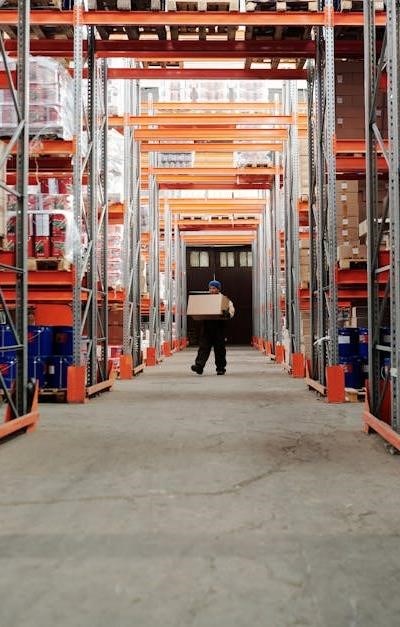
Global Supply Chain Management demands a holistic view․ Effective logistics, procurement, and distribution are vital․
Prioritize visibility across your supply network․
Mastering international trade, including customs and tariffs, is crucial․ Focus on cost reduction while enhancing efficiency․
Strategic sourcing and robust supplier relationships underpin success․ Embrace optimization and prepare for potential disruption․
Understanding the Core Components
A robust supply chain isn’t merely a sequence of steps; it’s a complex, interconnected ecosystem․ At its heart lies materials management, ensuring the right resources are available when needed․ This feeds directly into procurement – the strategic sourcing of goods and services – demanding careful vendor management to foster strong supplier relationships․
Effective inventory control is paramount․ Balancing stock levels to meet demand planning forecasts while minimizing holding costs requires sophisticated forecasting techniques․ This is where lean manufacturing and just-in-time methodologies can deliver significant benefits, though they also heighten vulnerability to disruption․
Once goods are acquired, transportation becomes critical․ Selecting the optimal modes – road, rail, sea, or air – impacts both cost and speed․ This leads into warehousing, where efficient storage and retrieval processes are essential․ Finally, distribution ensures products reach their intended destination, culminating in seamless order fulfillment․ Don’t overlook the importance of reverse logistics for returns and repairs, completing the cycle․
Understanding how these components interact within your value chain is key․ A holistic approach, considering the entire flow from raw materials to end consumer, is vital for achieving true supply chain mastery․ Ignoring any single element can create bottlenecks and compromise overall performance․
Globalization & Its Challenges: Risk Management & Compliance
Globalization presents immense opportunities, but also introduces significant complexities․ Expanding your supply network internationally necessitates a proactive approach to risk management․ Geopolitical instability, natural disasters, and economic fluctuations can all cause disruption, demanding robust contingency planning․
International trade is governed by a labyrinth of regulations․ Strict adherence to trade compliance is non-negotiable, encompassing customs procedures, tariffs, and export controls․ Failure to comply can result in hefty fines, delays, and reputational damage․ Thorough due diligence is essential when selecting international partners․
The bullwhip effect – where small demand variations amplify upstream – is exacerbated in global chains․ Improved communication and data sharing are crucial to mitigate this․ Furthermore, consider the ethical implications of globalization․ Ethical sourcing and ensuring fair labor practices are increasingly important for brand reputation and consumer trust․
Supply chain resilience isn’t about predicting every possible disruption, but about building the capacity to adapt quickly․ Diversifying your sourcing base, nearshoring production, and establishing backup suppliers are all strategies to enhance your ability to weather storms․ Prioritize visibility throughout your extended supply chain to identify and address potential vulnerabilities proactively․
Leveraging Technology for a Digital Supply Chain
Embracing a digital supply chain is no longer optional – it’s essential for competitiveness․ Supply chain technology offers unprecedented opportunities for optimization and enhanced visibility․ Invest in systems that integrate your logistics, procurement, warehousing, and transportation processes․
Artificial intelligence (AI) and machine learning can revolutionize forecasting and demand planning, reducing inventory costs and improving order fulfillment․ IoT (Internet of Things) sensors provide real-time tracking of goods, enabling proactive risk management and improved responsiveness to disruption․
Blockchain technology offers a secure and transparent ledger for tracking products throughout the value chain, combating counterfeiting and enhancing traceability – vital for ethical sourcing․ Automated processes, powered by AI, streamline materials management and reduce manual errors․
However, technology implementation requires careful planning․ Ensure data security and interoperability between systems․ Focus on user training and change management to maximize adoption․ A truly digital supply chain isn’t just about the tools; it’s about fostering a data-driven culture and leveraging insights to drive continuous improvement in efficiency and agility․ Consider the impact on supplier relationships and establish collaborative platforms for data sharing․
Optimization & Future-Proofing: Towards Supply Chain Resilience
Building a Sustainable & Agile Supply Network
Today’s environment demands more than just efficiency; it requires a sustainable and agile supply network․ Prioritize ethical sourcing and environmentally responsible practices throughout your value chain․ This isn’t solely about corporate social responsibility – it’s about mitigating risk and building long-term resilience․
Globalization introduces complexities, necessitating a diversified sourcing strategy․ Reduce reliance on single suppliers and geographic regions to buffer against disruption․ Implement robust contingency planning and develop alternative transportation routes․ Embrace lean manufacturing principles and just-in-time inventory management, but with strategic safety stock levels to avoid the bullwhip effect․
Foster strong supplier relationships built on collaboration and transparency․ Invest in vendor management programs that assess and improve supplier performance in areas of sustainability, quality, and delivery․ Develop a responsive distribution network capable of adapting to changing demand planning scenarios․
Reverse logistics is increasingly important – design processes for efficient returns, repairs, and recycling․ A truly agile network anticipates change, leveraging data analytics to identify potential vulnerabilities and proactively adjust strategies․ Focus on building agility not just within your own organization, but throughout your entire supply network, ensuring collective resilience and a commitment to long-term sustainability․




This is a solid overview of global supply chain management! I particularly appreciate the emphasis on visibility – it
A very well-structured piece! The breakdown of core components is particularly helpful for those new to the field. I